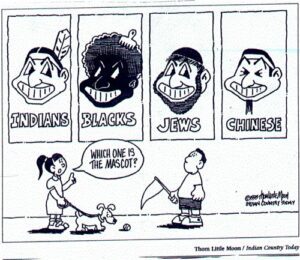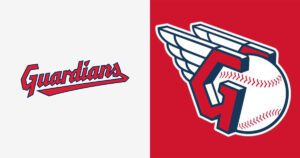Chief Wahoo is gone
It was in 1989 when the Publisher of the Lakota Times (the original Lakota Times), Tim Giago, got a phone call from a graduate student at the University of Illinois named Charlene Teters.
Teters had read a column Giago had written about the use of Native Americans as mascots for sports teams.
In 1989, Teters had reacted strongly to the performance of a pseudo-Native American dance by a white student portraying “Chief Illiniwek,” the school’s mascot at a university basketball game and soon after began to protest silently outside athletic events while holding a small sign reading “Indians are human beings.” Her actions and those of other Native American students at the University of Illinois, such as Marcus Amerman, led to a strong upswing in efforts to eliminate Native American imagery in school, university, and university athletics throughout the United States and a film (In Whose Honor by Jay Rosenstein) was produced on the subject.
Teters asked Giago to cover the upcoming football game at the University of Illinois where she and several Native Americans would be staging a protest. She wanted him to see firsthand how the fans of the Fighting Illini were treating the protestors.
Giago flew to Champaign, Illinois to attend the game. He walked with the protestors to the stadium and was astounded to see the Illini fans spitting at the protestors, throwing burning cigarettes at them, and screaming out racist slurs. “Go back to the reservation,” they shouted.
At halftime of the game a young white man wearing a leather shirt and pants, his face painted, and wearing feathers in his hair, danced out to the center of the football field and did some of the most hideous dances any of the protestors had ever seen, dances that were supposed to be Indian dances.
From that moment on it took several years but Teters and her fellow protestors were able to get the hideous Chief Illiniwek removed as the school’s mascot. And that was only the beginning.
In 1991 Teters, Michael Haney, Seminole, Vernon Bellecourt, Ojibwe, and Giago, Oglala Lakota, were in Minneapolis to protest the mascot of the Washington football team, “Redskins.” It was a peaceful protest until some of the ardent Redskin fans began to attack and abuse the protestors. And then the Minneapolis police stepped in and instead of stopping the Redskin fans, they attacked the Native American protestors. Teters was knocked to the ground when a policeman hit her with his night stick and Giago had his camera torn from his neck and the film removed from it.
A few weeks after this incident Oprah Winfrey asked Giago, Suzanne Harjo and Michael Haney to be on her Oprah Winfrey Show to talk about why Native Americans objected to the Washington team using “Redskins” as their mascot. It was the first time Native Americans ever appeared on a national TV show to talk about why they were against being used as mascots.
The news this week that the Cleveland Indians had dropped the “Indians” and were changing their mascot to “Guardians” was the culmination of the many years people like Teters, Bellecourt, Harjo, Haney, Giago and others had fought long and hard to get them to drop “Indians” as their mascot.
Giago recalled getting a letter from the Lakota mother of a ten year old girl. The girl asked her mother, “Are we bad people?” The mother wondered why she would ask that. The little girls said, “I was watching a football game with Dad and the people were wearing feathers, and they had painted faces and they were doing a tomahawk chop. And then they took a couple of little pigs that were painted red, put feathers on them and the chased them around the football field.”
Her mother tried to explain to her daughter that these were fanatical football fans who thought they had to dress up like Indians in order to support their team.
Charlene Teters said this week that it has been a long, hard struggle, “But we finally got the job done.” Michael Haney and Vernon Bellecourt passed away in the ensuing years, and Teters said she wished they were still alive to celebrate this great victory with her.
Giago said, “There will be no more painted faces or tomahawk chops at the Washington football games, and the hideous caricature of “Chief Wahoo” will not be seen anymore at the Cleveland baseball games. Some will say that our protests did no good, but I believe if some of us did not protest and make the noise to stop the use of racist mascots, nothing would have changed.”
The post Chief Wahoo is gone first appeared on Native Sun News Today.


